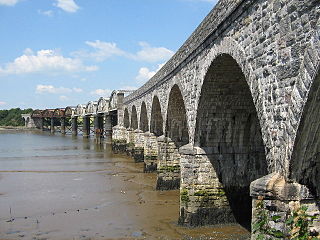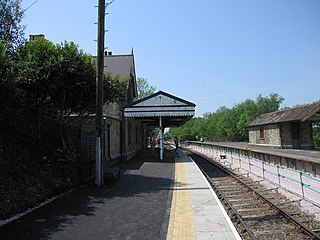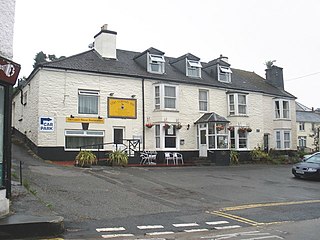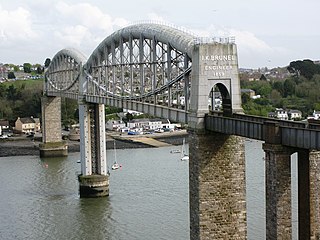
The Tamar is a river in south west England that forms most of the border between Devon and Cornwall. A large part of the valley of the Tamar is protected as the Tamar Valley National Landscape, and some is included in the Cornwall and West Devon Mining Landscape due to its historic mining activities.

Callington is a civil parish and town in east Cornwall, England, United Kingdom about 7 miles (11 km) north of Saltash and 9 miles (14 km) south of Launceston.

Kit Hill, at 334 metres high, dominates the area between Callington and the River Tamar in southeast Cornwall, England, UK. The word 'Kit' comes from Old English for kite, a reference to birds of prey. Buzzards and sparrowhawks can still be seen on the hill. It is one of five Marilyn hills in Cornwall, the four others are Watch Croft, Brown Willy, Carnmenellis and Hensbarrow Beacon.

The Tamar Valley Line is a railway line from Plymouth, Devon, to Gunnislake, Cornwall, in England, also known as the Gunnislake branch line. The line follows the River Tamar for much of its route. Like all railway lines in Devon and Cornwall, it is unelectrified and all trains are diesel powered. The entire line is single track past St. Budeaux Junction.

The Plymouth, Devonport and South Western Junction Railway (PD&SWJR) was an English railway company. It constructed a main line railway between Lydford and Devonport, in Devon, England, enabling the London and South Western Railway (LSWR) to reach Plymouth more conveniently than before.

Devonport railway station serves the Devonport area of Plymouth in Devon, England. It is 248 miles 28 chains (399.7 km) from London Paddington measured via Box and Plymouth Millbay. It is managed by Great Western Railway.

Dockyard railway station is a Great Western Railway suburban station on the Cornish Main Line in Devonport, Plymouth, England. As the name implies, it serves Devonport Dockyard. It is 248 miles 60 chains (400.3 km) from London Paddington via Box and Plymouth Millbay.

Keyham railway station is a suburban station in the city of Plymouth, Devon, England. It is 249 miles 25 chains (401.2 km) from London Paddington via Box and Plymouth Millbay. The station is close to the Devonport dockyard.

St Budeaux Victoria Road railway station is a suburban station in St Budeaux, Plymouth, Devon, England. The station is managed and served by Great Western Railway.

Bere Ferrers station on the Tamar Valley Line is situated near the village of Bere Ferrers in Devon, England. The station is on the former Southern main line between Exeter and Plymouth via Okehampton. It is currently operated by Great Western Railway (GWR).

Calstock is a civil parish and a large village in south east Cornwall, England, United Kingdom, on the border with Devon. The village is situated on the River Tamar 6 miles (9.7 km) south west of Tavistock and 10 miles (16 km) north of Plymouth.

Bere Alston railway station serves the village of Bere Alston in Devon, England, 10+1⁄4 miles (16.5 km) north of Plymouth on the Tamar Valley Line to Gunnislake.

Gunnislake railway station serves the village of Gunnislake in Cornwall, England. There are also connecting buses from here to the town of Tavistock. However the station is located in or nearer to the villages of Drakewalls and Albaston. It is the northern terminus of the Tamar Valley Line from Plymouth.

Gunnislake is a large village in east Cornwall, England, United Kingdom. It is situated in the Tamar Valley approximately ten miles (16 km) north of Plymouth The first woman cabinet minister in the British Empire, Mary Ellen Smith, was born here in 1863.
The East Cornwall Mineral Railway was a 1,067 mm gauge railway line, opened in 1872 to connect mines and quarries in the Callington and Gunnislake areas in east Cornwall, England, with shipping at Calstock on the River Tamar. The line included a rope-worked incline to descend to the quay at Calstock.

The Cornish Main Line is a railway line in Cornwall and Devon in the United Kingdom. It runs from Penzance to Plymouth, crossing from Cornwall into Devon over the Royal Albert Bridge at Saltash.

The Exeter to Plymouth railway of the London and South Western Railway (LSWR) was the westernmost part of a route competing with that of the Great Western Railway (GWR) and its 'associated companies' from London and Exeter to Plymouth in Devon, England. Whereas the GWR route from Exeter followed the coast to Newton Abbot and then went around the southern edge of Dartmoor, the LSWR route followed the northern and western margins of Dartmoor, passing through the towns of Crediton, Okehampton, and Tavistock.
A rail ale trail is a marketing exercise in the United Kingdom that is designed to promote tourism to a rural area, by encouraging people to visit a series of pubs that are close to stations along a railway line. Participants are rewarded for visiting the pubs by train. In doing this they increase the number of passengers on the railway and bring money into the local economy. The scheme is often supported by the Campaign for Real Ale. The beer is usually brewed locally and many of the pubs offer food as well.

The Devon and Cornwall Rail Partnership is the largest Community Rail Partnership in the United Kingdom. It was formed in 1991 to promote the use of, and improvements to, rural railways in Devon and Cornwall, and also to promote the places served in order to improve the local economy.

The network of railways in Plymouth, Devon, England, was developed by companies affiliated to two competing railways, the Great Western Railway and the London and South Western Railway. At their height two main lines and three branch lines served 28 stations in the Plymouth area, but today just six stations remain in use.



















